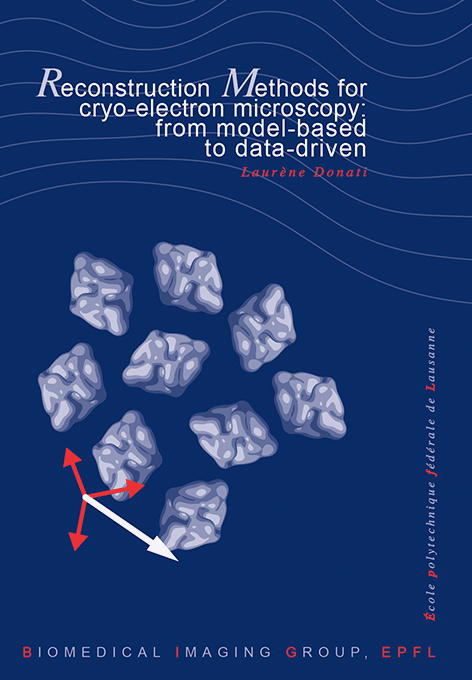Reconstruction Methods for Cryo-Electron Microscopy: From Model-Based to Data-Driven
L. Donati
École polytechnique fédérale de Lausanne, EPFL Thesis no. 7540 (2020), 215 p., September 18, 2020.
The topic of this thesis is the development of new reconstruction methods for cryo-electron microscopy (cryo-EM). Cryo-EM has revolutionized the field of structural biology over the last decade and now permits the regular discovery of biostructures. Yet, the technical challenges associated to cryo-EM are still numerous, and the measurements remain notoriously difficult to process. This calls for fast and robust algorithms that can reliably handle the challenging reconstruction task at hand.
In this thesis, we investigated two reconstruction paradigms: model-based and data-driven. Model-based methods formulate the reconstruction task as an inverse problem and rely on a faithful model of the acquisition physics. By contrast, the central philosophy of data-driven approaches is to let the reconstruction algorithm be guided by the measured data through some learning procedure. Both paradigms share a tight link in all our works: their reliance on a rigorous mathematical formulation of the cryo-EM imaging model.
The first cryo-EM method we considered is scanning transmission electron tomography (STET), a modality whose primary concern is to reduce the electron dosage required for accurate imaging. To handle this, we developed a tailored acquisition-reconstruction STET framework that relies on the principles of compressed sensing. This scheme permits high-quality reconstruction from a reduced number of measurements, hence greatly preserving the sample.
We then designed several reconstruction algorithms for single-particle analysis (SPA), a popular cryo-EM method that enables the determination of structures at near-atomic resolution. A key challenge for the deployment of robust, iterative reconstruction methods in SPA is that they usually come with a prohibitive computational cost if not carefully engineered. To circumvent this problem, we developed a regularized reconstruction scheme whose cost-dominant operation is recast as a discrete convolution, which makes the use of our robust scheme feasible in SPA. Building on this development, we devised a joint optimization framework that efficiently alternates between the reconstruction and the estimation of the unknown orientations.
We then explored a learning-based method to estimate the unknown orientations in SPA directly from the acquired dataset of projections. Capitalizing on our ability to model the cryo-EM procedure, we generated large synthetic SPA datasets to train a function—parametrized as a neural network—to predict the relative orientation between two projections based on their similarity. The framework relies on the postulate that it is possible to recover, from these estimated orientation distances, the orientations themselves through an appropriate minimization scheme, as supported by preliminary tests.
Finally, we developed a completely new paradigm for SPA reconstruction that leverages the remarkable capability of deep neural networks to capture data distribution. The proposed algorithm uses a generative adversarial network to learn the 3D structure that has simulated projections that most closely match the real data in a distributional sense. By doing so, it can resolve a 3D structure in a single algorithmic run using only the dataset of projections and CTF estimations as inputs. Hence, it bypasses many processing steps that are necessary in the usual cryo-EM reconstruction pipeline, which opens new perspectives for reconstruction in SPA.

@PHDTHESIS(http://bigwww.epfl.ch/publications/donati2003.html,
AUTHOR="Donati, L.",
TITLE="Reconstruction Methods for Cryo-Electron Microscopy: {F}rom
Model-Based to Data-Driven",
SCHOOL="{\'{E}}cole polytechnique f{\'{e}}d{\'{e}}rale de {L}ausanne
({EPFL})",
YEAR="2020",
type="{EPFL} Thesis no.\ 7540 (2020), 215 p.",
address="",
month="September 18,",
note="")